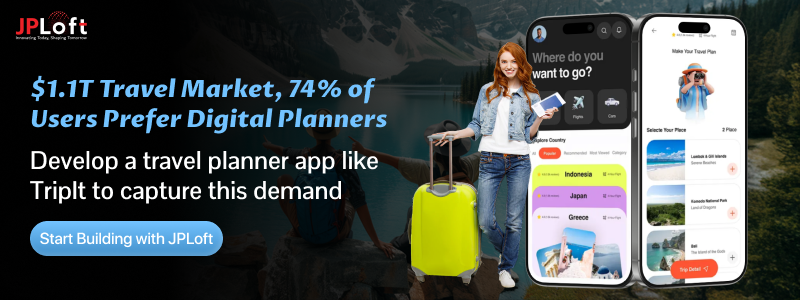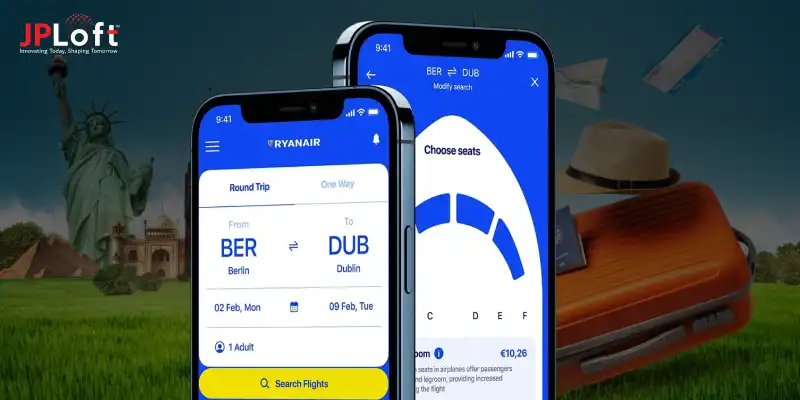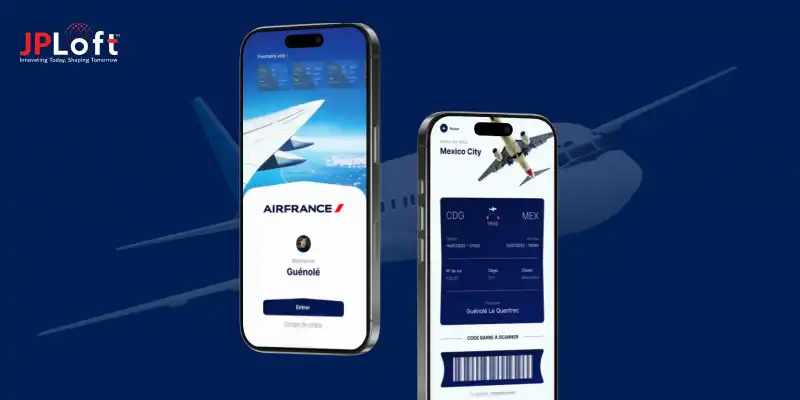"The world is a book, and those who do not travel read only one page."—Saint Augustine.
In today’s digital-first era, travelers expect more than just bookings; they want smart, seamless planning.
Many businesses are asking: how to develop a travel planner app like TripIt? The answer lies in combining intuitive design, robust functionality, and smart integrations to simplify itineraries and enhance the overall travel experience.
If you’re looking to make an app like TripIt, the opportunities in 2025 are massive, driven by AI, personalization, and rising demand for hassle-free travel.
In this blog, we’ll uncover everything you need to know to create a travel app planner like TripIt, from must-have features to costs, challenges, and future trends.
Key Takeaways
Travel planner apps like TripIt simplify journeys by consolidating flights, hotels, and activities into a single platform.
Core features such as itinerary management, real-time updates, and collaborative planning are essential for success.
Integrating AI and ML enhances personalization, predictive insights, and smart travel recommendations.
The cost to develop a travel planner app like TripIt depends on features, integrations, and platform choices, ranging from $40,000 to $200,000+.
Partnering with JPLoft gives you expert guidance at every stage from idea validation to app launch and beyond.
Tripit: An Overview of Travel Planner App
TripIt is one of the best travel apps available today, offering users a seamless way to organize all their travel plans in one place.
From flight bookings to hotel reservations, TripIt automatically compiles your itineraries, ensuring you never miss a detail.
For businesses and developers curious to know how to create a travel app, TripIt serves as a benchmark for intuitive design and functionality.
Its user-friendly interface, automated itinerary management, and real-time updates make it a popular choice among travelers worldwide.
If your goal is to make an app like TripIt, understanding how it consolidates multiple travel services into a single platform is key.
Features like easy calendar integration, notifications, and collaborative trip planning highlight why travelers trust TripIt for stress-free travel management.
Developers aiming to develop a travel planner app like TripIt should prioritize simplicity, automation, and real-time updates to deliver a competitive and engaging user experience.
Market Context: Why Develop an App like TripIt?
Developing a travel app like TripIt can be a smart investment, given the growing demand for organized, user-friendly travel planning solutions.
Here are some key reasons why businesses should consider entering this space:
A] High Demand for Travel Planning Apps
With travelers increasingly relying on mobile apps to organize trips, learning how to develop a travel planner app like TripIt ensures you can meet user expectations with seamless itinerary management.
B] Addressing Pain Points in Travel Management
Many travelers face challenges in consolidating flight, hotel, and activity bookings.
By understanding why online travel apps fail, developers can build solutions that solve real pain points and improve user retention.
C] Leveraging Modern Technology Trends
Travel app development trends like AR-based guides, AI suggestions, and real-time updates enhance engagement.
Staying updated helps developers create apps that are both innovative and competitive.
D] Opportunities for Revenue Generation
The market for travel apps offers various monetization models. By studying how apps like TripIt succeed, you can implement features that drive bookings, subscriptions, or partnerships effectively.
E] Competitive Benchmarking
Analyzing top travel apps provides insights into UI/UX best practices and feature sets.
Developers can build a TripIt clone or create a travel app planner like TripIt that stands out in a crowded marketplace.
How Does a Travel Planner App Like TripIt Work? Explained Simply
Travel planner apps like TripIt have transformed how travelers organize their trips.
Understanding their functionality helps developers aiming to develop a travel planner app like TripIt. Here’s a clear breakdown:
► Centralized Itinerary Management
TripIt collects travel details from emails, including flight bookings, hotel reservations, and car rentals. This centralization ensures users can access all trip information in one place.
Developers building a TripIt clone should focus on smooth data integration. Handling this effectively often involves overcoming common travel app development challenges to ensure a seamless experience.
► Automated Updates
Users receive real-time notifications about flight changes, delays, or cancellations, keeping them informed without manual effort.
Apps that replicate this functionality should incorporate reliable automated update systems. Ensuring timely and accurate updates is key for user trust.
This feature enhances convenience and engagement in any TripIt clone.
► Collaborative Planning
TripIt allows sharing itineraries with friends, family, or colleagues, making group travel easier. Developers planning to make a TripIt clone should integrate collaborative features.
This increases app engagement and usability while encouraging repeated use. Social and shared planning features have become a core expectation for travelers today.
► Calendar and Reminder Integration
TripIt syncs travel plans with users’ calendars and sets reminders for key activities. Ensuring smooth calendar integration is crucial when developing a travel booking app like TripIt.
Notifications and reminders improve user convenience and reduce missed events. This functionality strengthens user reliance on the app for trip management.
► Innovative Features and UX Enhancements
Some competitors are integrating AR in travel apps to provide interactive maps or immersive previews of destinations.
Including such features can enhance user experience and engagement. Developers should explore creative UX enhancements to differentiate their apps.
Innovative elements make a travel app both functional and appealing.
► Data Security and User Privacy
Handling sensitive travel data requires robust security measures and privacy protocols. Apps must implement encryption and follow best practices to protect user information.
Ensuring data security builds trust and long-term user loyalty. A secure TripIt clone enhances credibility and market adoption.
Must-Have Features to Include in a TripIt-Like Travel App
TripIt sets the standard for travel planning apps, offering seamless itinerary management and convenience for users.
For developers aiming to develop a travel planner app like TripIt, understanding essential features ensures a competitive and engaging product.
This guide highlights core functionalities to create a TripIt clone that stands out in 2025.
1. Centralized Itinerary Management
TripIt consolidates flight, hotel, and transportation details into one organized itinerary.
Smooth data aggregation and clear display are essential for usability. This feature is a must when you create a travel app planner like TripIt.
2. Real-Time Updates & Notifications
Automatic alerts for flight delays, gate changes, and cancellations keep travelers informed.
Developers planning how to develop a travel planner app like TripIt should integrate timely notifications for reliability.
Real-time updates remain a crucial aspect that users expect for a smooth and dependable travel experience.
3. Collaborative Trip Planning
Sharing itineraries with friends, family, or colleagues improves engagement and convenience. Collaborative features make group travel seamless.
Studying how to create an app like Omio can help developers implement effective shared travel experiences.
4. Booking Integration & Recommendations
In-app bookings for flights, hotels, and activities simplify planning for users. Personalized suggestions enhance usability and satisfaction.
This approach aligns with how to make an app like Tripadvisor, merging planning with discovery.
5. Calendar Sync & Reminders
Syncing itineraries with personal calendars and sending reminders keeps travelers organized.
It ensures users don’t miss key activities during trips. This feature is vital when you develop a TripIt clone with enhanced engagement.
6. Secure Payments & Data Protection
Handling travel bookings and sensitive user data securely builds trust. Encrypting information and following privacy protocols are essential steps.
Prioritizing travel app security ensures robust protection for sensitive user data and builds lasting trust.
7. Innovative Add-Ons (Optional)
Optional features like AR navigation, AI recommendations, or offline access improve user experience.
These add-ons help your app stand out while keeping core functionality intact. Integrating them strategically supports your step-by-step guide to develop an app like TripIt.
How to Create a Travel Planner App Like TripIt?
Wondering how to create a travel planner app like TripIt? It requires a strategic approach that combines intuitive design, robust functionality, and seamless integrations.
Following these steps can help you create a mobile app that enhances travel experiences and simplifies itinerary management.
Step 1: Market Research and Goal Setting
Understanding the travel market and setting clear objectives is crucial before starting development. This ensures your app meets real user needs and stands out.
A) Define Target Audience
Identify traveler types, booking preferences, and demographics. Knowing your audience helps design features that truly solve their problems and enhance engagement.
B) Study Competitors
Analyze apps like TripIt and Kayak to understand their strengths and weaknesses. This also helps you plan how to develop an app like Kayak with unique and competitive features.
C) Set Clear Objectives
Decide if the app will focus on itinerary management, booking integration, or AI-based suggestions. Clear goals guide development priorities and resource allocation efficiently.
D) Identify Unique Value
Determine what differentiates your app, such as AI recommendations, multi-platform support, or personalized alerts. Unique value propositions attract and retain loyal users.
Step 2: Feature Planning and Architecture
Careful feature planning and robust architecture are essential to ensure usability, engagement, and future scalability.
Including top travel app features helps create an app that feels intuitive, engaging, and seamless for users.
A) Core Functionalities
Include itinerary aggregation, booking synchronization, reminders, and calendar integration. These core functionalities form the foundation for a smooth and intuitive travel experience.
B) Integration with Travel Services
Connect with flight, hotel, and transportation APIs to provide real-time updates. This is a key element of TripIt app like development, ensuring travelers get accurate, timely information.
C) Security and Data Privacy
Encrypt user data and comply with GDPR or local regulations. Implementing strong encryption and complying with privacy regulations builds trust and safeguards sensitive traveler information.
D) AI-Driven Recommendations
Leverage AI to offer personalized suggestions, smart itineraries, and travel alerts. Integrating AI enhances user engagement and encourages repeat app usage.
Step 3: UI/UX Design
A visually appealing and intuitive interface keeps users engaged and encourages repeat usage. Thoughtful design enhances usability and strengthens brand trust.
A) Mobile-Optimized Layouts
Create responsive layouts that work seamlessly on both iOS and Android devices. Following how to design a travel app ensures a consistent and enjoyable experience across platforms.
B) Intuitive Navigation
Implement simple menus, quick search features, and easy-to-edit itineraries. Intuitive navigation allows travelers to access information effortlessly, reducing frustration and increasing retention.
C) Personalization and Dashboards
Enable users to customize dashboards and recommendations according to their preferences. Personalized interfaces create a sense of ownership and improve overall satisfaction.
D) Accessibility Features
Ensure readability, voice commands, and adaptable UI elements to accommodate all user groups. Accessibility fosters inclusivity and expands your app’s potential user base.
Step 4: Backend Development and AI Integration
A strong backend ensures real-time updates, AI-driven suggestions, and app scalability. Efficient architecture forms the foundation of a smooth travel experience.
A) Scalable Server Architecture
Design servers capable of handling multiple users and large datasets efficiently. Scalable infrastructure ensures your app performs well even during peak usage.
B) Database Management
Use structured databases to store itineraries, bookings, and user profiles securely. Efficient database management practices help maintain long-term reliability and performance.
C) Third-Party API Integration
Integrate with travel, payment, and mapping APIs for real-time, accurate information. This is crucial for delivering seamless live booking features that travelers expect.
D) AI & Machine Learning Models
Implement AI for predictive recommendations, automated itinerary suggestions, and personalized notifications. AI-driven features enhance user engagement and app stickiness.
Step 5: Development Team and Resources
Assembling the right team is crucial for delivering a high-quality travel app. Skilled professionals ensure smooth development and timely delivery.
A) Skilled Professionals for App Success
Hire dedicated developers, designers, and AI specialists for focused project execution. This approach guarantees to build a TripIt clone efficiently.
B) Outsourcing to Experts
Collaborate with a trusted mobile app development company UK to leverage industry experience and best practices. Outsourcing reduces risks and accelerates project timelines.
C) Project Management
Implement Agile or Scrum methodologies to streamline tasks, track progress, and maintain quality. Proper project management ensures milestones are met efficiently.
D) Continuous Learning
Keep your team updated with the latest technologies, tools, and travel industry trends. Continuous learning helps improve features, functionalities and overall performance of the under-construction travel app planner like TripIt.
Step 6: Frontend Implementation and App Logic
Frontend development brings the app design to life, ensuring smooth interactions and visual appeal. A well-implemented frontend keeps users engaged and satisfied.
A) Smooth Navigation and Interactive UI
Incorporate intuitive menus, drag-and-drop itinerary features, and dynamic content to enhance usability. A well-structured UI/UX significantly improves user engagement.
B) Multi-Platform Compatibility
Build the app for iOS, Android, and web platforms to reach a wider audience. Cross-platform development ensures consistent experience across devices.
C) Real-Time Data Updates
Enable live syncing of itineraries, booking confirmations, and push notifications for accuracy. This is essential for TripIt app development.
D) Integration with User Accounts
Allow login via email, social media, or travel services for convenience. Secure account integration improves personalization and user retention.
Step 7: Testing and Quality Assurance
Thorough testing ensures the app is reliable, secure, and offers a seamless user experience. High-quality assurance builds user trust and satisfaction.
A) Functional Testing
Verify all app workflows, API integrations, and AI-driven features for smooth operation. This step is critical when you make an app like TripIt.
B) Usability Testing
Evaluate the app’s interface, navigation, and accessibility to ensure it meets user expectations. A user-friendly design encourages retention and engagement.
C) Beta Testing
Launch the app to a limited audience to collect real-world feedback. Iterative improvements at this stage help refine the app before full release.
D) Performance Monitoring
Track speed, responsiveness, memory usage, and crash reports to maintain optimal performance. Continuous monitoring is key when you build a TripIt Clone.
Step 8: Deployment, Maintenance, and Marketing
Post-launch strategies are crucial to sustain app growth, user engagement, and long-term success. Proper planning ensures your travel app remains competitive.
A) App Store Deployment
Optimize app store listings with compelling descriptions, visuals, and keywords. This helps attract downloads when you create a travel app like TripIt.
B) Continuous Updates and Support
Work with mobile app maintenance services to release timely updates, fix bugs, and enhance features. Regular maintenance keeps users satisfied.
C) Analytics and Insights
Track user behavior, retention, and engagement metrics. Insights guide improvements, allowing you to evolve the app based on real usage patterns.
D) Marketing and Growth Strategy
Promote the app through social media, travel partnerships, and paid campaigns. Hiring dedicated developers and marketing experts can boost growth and reach.
Can AI be Helpful in Building an App Like TripIt?
AI has revolutionized the way travel apps operate, enhancing personalization, efficiency, and user engagement.
Integrating AI in your TripIt clone can make itineraries smarter, automate recommendations, and improve overall app functionality.
Here’s how AI can play a key role in developing a travel planner app like TripIt.
1. AI-Driven Personalization
AI algorithms can analyze user preferences, travel history, and behavior to provide tailored suggestions.
This feature helps in how to build an AI travel agent by offering relevant recommendations for flights, hotels, or activities.
Personalization increases user retention and satisfaction, making your app more competitive in the travel market.
2. Smart Itinerary Planning
Leveraging AI ensures that itineraries are optimized for time, cost, and convenience. Users can automatically receive suggestions for route adjustments or new attractions.
This approach makes it easier for entrepreneurs to create an AI app that delivers real-time, context-aware travel planning.
3. Automating Customer Support
AI chatbots and virtual assistants can answer queries, manage bookings, and provide 24/7 support.
Companies can outsource solutions to AI app development services to implement seamless interactions.
This reduces human workload and improves the overall user experience, making the app highly efficient.
4. Predictive Analytics for Travel Trends
AI can predict travel trends, popular destinations, and pricing fluctuations, allowing users to plan ahead.
This capability demonstrates the potential of AI in hospitality to enhance the app ecosystem.
Integrating predictive analytics helps your TripIt clone deliver smarter and more timely suggestions.
5. Enhancing Booking and Notification Systems
AI enables automatic updates for flight delays, gate changes, or booking confirmations.
By incorporating these features, you can make an app like TripIt that proactively assists travelers.
Timely notifications and smart reminders increase engagement and reduce user friction during trips.
6. Optimizing Business Operations
From itinerary aggregation to recommendation engines, AI streamlines backend processes.
Entrepreneurs looking for a roadmap on how to develop a travel planner app like TripIt? can rely on AI for data-driven insights, operational efficiency, and user satisfaction.
This step is essential in a TripIt app like development.
What’s the Cost to Make an App Like TripIt?
On average, the cost to create an app like Tripit falls in the range of $50,000 to $200,000
Understanding the cost to make an app like TripIt is essential for planning your budget and resources.
Mobile app development costs vary based on features, platforms, integrations, and the level of AI personalization included in your TripIt clone.
If you are planning to create a travel app planner like Tripit, proper cost estimation following the cost breakdown given below ensures realistic timelines and sustainable investment.
Let’s break down the key factors and benchmarks.
► Core Development Costs
Building the foundational architecture, including user accounts, itinerary management, and booking APIs, forms the bulk of the budget.
Depending on complexity, the cost to develop a travel app can range from $40,000 to $120,000.
For businesses exploring how to develop a travel planner app like Tripit?, it’s crucial to account for scalable backend systems.
► Platform and Technology Expenses
Developing for iOS, Android, and web platforms increases costs but maximizes reach.
Integrating advanced AI features, real-time notifications, and dynamic itineraries can further elevate expenses.
When considering the cost to create an app like Agoda, which involves complex booking engines, you get a realistic benchmark for multi-platform development.
► UI/UX Design Costs
A smooth and interactive design is key to user retention. Travel app interfaces demand intuitive navigation, drag-and-drop itinerary features, and visually appealing layouts.
Entrepreneurs planning how to develop an app like Tripit? should budget adequately for professional design services to ensure engagement.
► Third-Party Integrations
Integrating flight, hotel, and activity APIs, along with payment gateways and AI tools, requires specialized development efforts.
For premium apps, using the cost to develop a travel app like Visit Dubai as a reference helps estimate higher-end integration costs for luxury travel services.
► Testing and Maintenance
Thorough QA, beta testing, and ongoing updates are essential for reliability. Outsourcing to experienced teams can reduce risks and improve performance.
Businesses looking for a step by step guide to develop an app like Tripit should include recurring maintenance in their financial planning.
How Does a Travel Planner App Like TripIt Make Money?
Monetization is a critical factor when planning how to develop a travel planner app like Tripit?
Choosing the right revenue streams ensures sustainability while maintaining user satisfaction.
Travel apps like TripIt combine convenience with premium services, making multiple travel app monetization strategies possible.
1. Subscription-Based Model
Offering premium features, such as AI-powered itinerary suggestions or priority support, can generate recurring revenue.
Users can access basic features for free while subscribing to advanced functionalities.
Entrepreneurs looking for a step by step guide to develop an app like Tripit should incorporate subscription tiers in the planning phase.
2. In-App Advertising
Displaying contextually relevant ads from travel partners or local services can generate passive income.
Carefully integrating ads ensures minimal disruption to user experience while capitalizing on high engagement rates.
For businesses planning how to build an app like Tripit?, ad monetization is a reliable secondary revenue stream.
3. Affiliate Marketing & Partnerships
Partnering with airlines, hotels, and activity providers allows apps to earn commissions on bookings.
Integrating affiliate programs into your TripIt clone can substantially increase revenue.
Those considering making an app like Tripit should explore strategic partnerships to enhance monetization.
4. Booking Commissions
Earning a percentage from hotel, flight, or tour bookings made through the app provides a consistent revenue source.
For entrepreneurs exploring creating an app like Tripit, building seamless booking flows encourages higher conversion rates, directly impacting profitability.
5. Freemium Upgrades
Providing a freemium model with optional upgrades for features like real-time travel alerts or AI trip suggestions can drive incremental revenue.
Startups planning how to develop an app like Tripit? must balance free and paid features to retain users while monetizing effectively.
6. Data-Driven Services
Aggregating anonymized user travel data can create insights for tourism boards, travel brands, or analytics firms.
Apps developed using a guide to create an app like Tripit approach can leverage data responsibly to generate additional income streams.
For businesses aiming to develop a travel booking app like TripIt, combining these app monetization strategies during the Tripit app like development process ensures a robust business model while delivering valuable user experiences.
Partner with JPLoft to Build It
Building a successful travel planner app requires more than just an idea; it needs the right expertise.
As a leading travel app development company, JPLoft helps you transform your vision into a scalable product.
Whether you’re exploring how to develop a travel planner app like TripIt or want a custom solution with unique features, our team guides you through every step from design to launch.
Partner with us to create an app that delivers seamless travel experiences and long-term growth.
Conclusion
Creating a travel planner app like TripIt requires a balance of intuitive design, reliable features, and future-ready technologies.
From concept to deployment, every step plays a critical role in shaping the app’s success.
By focusing on user needs, continuous innovation, and a strong post-launch strategy, businesses can stand out in the competitive travel industry.
With the right development partner, you can turn your idea into a seamless digital solution that simplifies journeys and enhances traveler experiences.
FAQs
Developing a TripIt-like travel planner requires defining core features such as itinerary management, real-time updates, AI-powered suggestions, and offline access. The process involves research, design, development, testing, and post-launch support.
The cost depends on factors like app complexity, chosen platform (iOS/Android), design sophistication, and developer region. On average, creating such an app can range from $40,000 to $150,000+.
Building a TripIt-like app can take anywhere between 4 to 9 months, depending on the features, integrations, and team expertise
Features such as centralized itinerary management, flight status tracking, hotel and transport bookings, AI-based travel suggestions, and push notifications are essential for user convenience.
Yes. AI and ML can improve personalization, provide smart travel recommendations, and help predict delays or optimize itineraries, enhancing user engagement.
The process includes ideation, competitor research, UI/UX design, development, API integrations, testing, deployment, and continuous app maintenance.













Share this blog